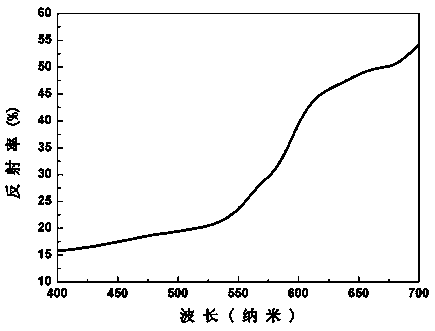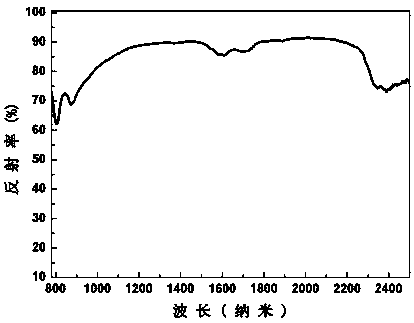Ceramic pigment with high near-infrared reflectivity, and preparation method thereof
A ceramic pigment, high reflectivity technology, applied in chemical instruments and methods, fibrous fillers, inorganic pigment treatment, etc., can solve problems such as aging, achieve simple process, high near-infrared reflectivity, and be conducive to industrial application Effect
- Summary
- Abstract
- Description
- Claims
- Application Information
AI Technical Summary
Problems solved by technology
Method used
Image
Examples
Embodiment 1
[0031] The preparation of near-infrared high-reflectivity ceramic pigments specifically includes the following process steps:
[0032] (1) Prepare 180 ml of water / alcohol solution ( V 水 : V 乙醇 = 1 : 5), then add 0.1 mole of tetraethyl orthosilicate, stir for 5 minutes, then add 0.3 mole of citric acid as a chelating agent, and use magnetic stirring at the same time to form a transparent sol;
[0033] (2) According to the chemical composition Nd 1.7 Fe 0.3 Si 2 o 7 Weigh neodymium nitrate and ferrous sulfate, fully dissolve them in 50 ml of deionized water, and add them to the transparent sol in step (1) in sequence, and stir thoroughly for 1 hour. The sol was then moved to a water bath at 90° C. and stirred for 1 hour, and then stirred continuously in an oil bath at 130° C. for 2 hours to obtain a xerogel.
[0034] (3) The dry gel was heat-treated at 1000°C for 3 hours, and then cooled, crushed, ground, pickled, washed with water and dried to obtain near-infrared high...
Embodiment 2
[0038] The preparation of near-infrared high-reflectivity ceramic pigments specifically includes the following process steps:
[0039] (1) Prepare 180 ml of water / alcohol solution ( V 水 : V 乙醇 = 1 : 3), then add 0.1 mole of sodium silicate, stir for 5 minutes, then add 0.5 mole of citric acid as a chelating agent, and use magnetic stirring at the same time to form a transparent sol;
[0040] (2) According to the chemical composition Nd 1.9 Fe 0.1 Si 2 o 7 Weigh neodymium sulfate and ferric chloride, fully dissolve them in 50 ml of deionized water, respectively, and add them to the transparent sol in step (1) in sequence, and fully stir for 2 hours. The sol was then moved to a water bath at 80° C. and stirred for 1 hour, and then stirred continuously in an oil bath at 120° C. for 1.5 hours to obtain a xerogel.
[0041] (3) The dry gel was heat-treated at 1300°C for 1 hour, and then cooled, crushed, ground, pickled, washed with water and dried to obtain a near-infrared ...
Embodiment 3
[0044] The preparation of near-infrared high-reflectivity ceramic pigments specifically includes the following process steps:
[0045] (1) Prepare 180 ml of water / alcohol solution ( V 水 : V 乙醇 = 1 : 4), then add 0.1 mole of sodium silicate, stir for 5 minutes, then add 0.4 mole of citric acid as a chelating agent, and use magnetic stirring to form a transparent sol;
[0046] (2) According to the chemical composition Nd 1.95 Fe 0.05 Si 2 o 7 Weigh neodymium chloride and ferrous nitrate, fully dissolve them in 50 ml of deionized water, and add them to the transparent sol in step (1) in sequence, and stir thoroughly for 1 hour. Then the sol was moved to a water bath at 85° C. and stirred for 1 hour, and then stirred continuously in an oil bath at 140° C. for 1 hour to obtain a xerogel.
[0047] (3) The dry gel was heat-treated at 1200°C for 2 hours, and then cooled, crushed, ground, pickled, washed with water and dried to obtain near-infrared high-reflectivity ceramic pigm...
PUM
| Property | Measurement | Unit |
|---|---|---|
| reflectance | aaaaa | aaaaa |
| reflectance | aaaaa | aaaaa |
Abstract
Description
Claims
Application Information
 Login to View More
Login to View More - R&D
- Intellectual Property
- Life Sciences
- Materials
- Tech Scout
- Unparalleled Data Quality
- Higher Quality Content
- 60% Fewer Hallucinations
Browse by: Latest US Patents, China's latest patents, Technical Efficacy Thesaurus, Application Domain, Technology Topic, Popular Technical Reports.
© 2025 PatSnap. All rights reserved.Legal|Privacy policy|Modern Slavery Act Transparency Statement|Sitemap|About US| Contact US: help@patsnap.com


